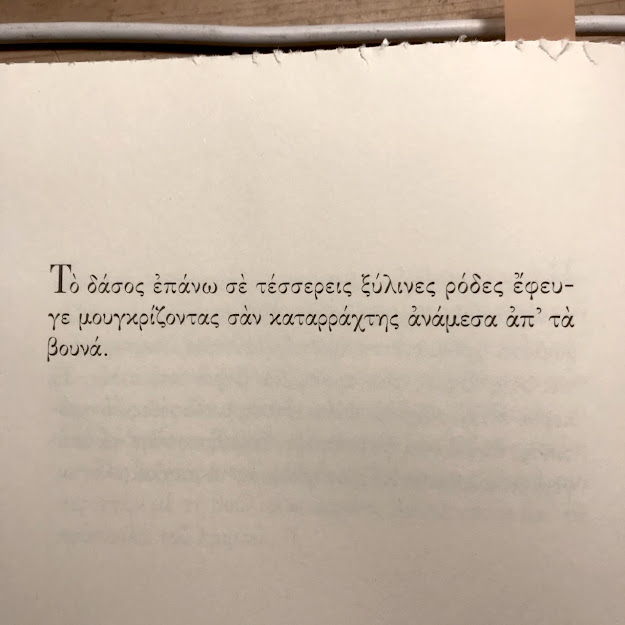Thursday, July 30, 2020
Dewlen House
Bruce Alonzo Goff (American, 1904-1982). Twelve Dewlen House Architectural Renderings, 1956. Print with handcoloring
Thursday, July 23, 2020
199
Deste Foundation/ National Historical Museum of Athens
#funerary #masks #destefoundation#nhmuseumofathens #collection #brass#sculpture #kostisvelonis #fighters#greekrevolution #filikietairia #hydra #199 — at Hydra Island Greece.
Ghost Beggar Catalogue
Stormy Seas (Sleeping Island)
Oil, acrylic, pastel and colour pencil on paper
TAR exhibition
19/7- 29/8
Cur. by @danai_giannoglou
#drawing #tryfonartresidency #kostisvelonis#sleeping #island #stormyseas #koufonisia
Monday, July 13, 2020
Saturday, July 11, 2020
Indestructible (Broken)
Marble, wood, stones
199
27.6.2020-1.11.2020
Deste Foundation Project Space, Slaughterhouse, Hydra
#destefoundation #gravity #masonry #debate#sculpture #kostisvelonis #hydra #indestructible#marble #stones #transfiguration #boecklin#petrification #solidity #instability#hydraslaughterhouse #exhibition #199 — in Hydra, Greece.
Arnold Böcklin – Isle of the Dead
The title of this painting was apparently coined by the art dealer, while the artist himself referred to the painting only as “a picture for dreaming over”. A fascinating detail to be aware of because the morbid and mysterious allure of the painting lies half in its symbolist-laden title. I didn’t know for the painting before I discovered Rachmaninov’s composition of the same name a few years ago. The title is bewitching, and yet the painting itself looks like the world of nightmares which I inhabit in my slumber. I am drawn and repulsed by it, I fear being engulfed in its darkness, and yet I crave to unravel the mystery of those tall cypress trees.
Arnold Böcklin, Isle of the Dead, ‘Basel’ version, 1880
“Under ancient cypress trees, weeping dreams are harvested from sleep.” (Georg Trakl, tr. by Jay Hopler, from “Year,” published c. October 1912)
The painting shows a seemingly uninhabited little island, composed from strange massive yellowish rocks and built in classical style architecture, the purpose of which is unclear. The centre of the isle is occupied by tall and shadowy cypress trees which look, to me, as if they are corpses standing upright and decaying slowly. Their darkness exudes a nauseating scent and the way they loom over the isle silently gives their presence an ominous character. This is a place from the artist’s imagination, and all elements are subordinated to the mood which is one of dreams and death, some even say the mood is that of ‘withdrawal, of rejection of reality’ which makes sense in the context of Symbolism. Death dreamily hangs over the isle as a dark cloud heavy from rain; death hides in the soft trembling of the tired cypress trees; death lingers in the air in the rich and heavy scent of the Mediterranean. But the isle is not alone; a little rowboat is slowly gliding through the dark and still waters. On the boat we see an oarsman, a figure shrouded in white veils, resembling a statue or a mummy, and a coffin. Now, just when you thought things couldn’t get more symbolist if they wanted to! There are dozens of interpretations of this painting and its every detail offers many explanations. Some suggest the oarsman represents Charon, the boatman from Greek mythology who led souls to the underworld over the river Acheron. Perhaps defining the painting would mean stealing its richness of vague dreaminess and confining it to the genre of mythological scenes, and it’s much richer than that because its layers and layers of mystery serve to awaken the subconsciousness.
Island of Saint George
This painting is one of three versions or variations of a same theme that Böcklin painted. Even though the isle is the artist’s little fantasy, a dream-world and not a real place, it was inspired by a real place, and again, there are a few possibilities. One of them points to the islet called “Sveti Đorđe” (“Island of Saint George”) in Bay of Kotor in Montenegro. The only building on the islet is a Benedictine monastery from the 12th century and the abundance of tall and dark cypress trees are reminiscent of Böcklin’s paintings. It really is a dead isle; no one lives there apart from the wandering souls of the dead, and tourists are not allowed. Böcklin could have seen the islet on one of his travels to Italy. I am certain that in twilight it holds the same eerie spell on the observer as the isle in the painting does. Another possible inspiration is the Pontikonisi islet in Greece, again with plenty of cypress trees and a Byzantine chapel from the 12th century. I personally feel that there is a clear resemblance between the Island of Saint George and the third version of the painting “Isle of the Dead”, from 1883, where the rocky formations are sharp and grey, almost enveloping the isle, and the colour of the sea blends with that of the sky.
https://byronsmuse.wordpress.com/2018/06/14/arnold-bocklin-isle-of-the-dead/
Thursday, July 9, 2020
Thursday, July 2, 2020
Ευρύαλε γλαυκέων χαρίτων θάλος
καλλικόμων μελέδημα, σὲ μὲν Κύπρις
ἅ τ᾽ ἀγανοβλέφαρος Πει-
θὼ ῥοδέοισιν ἐν ἄνθεσι θρέψαν











